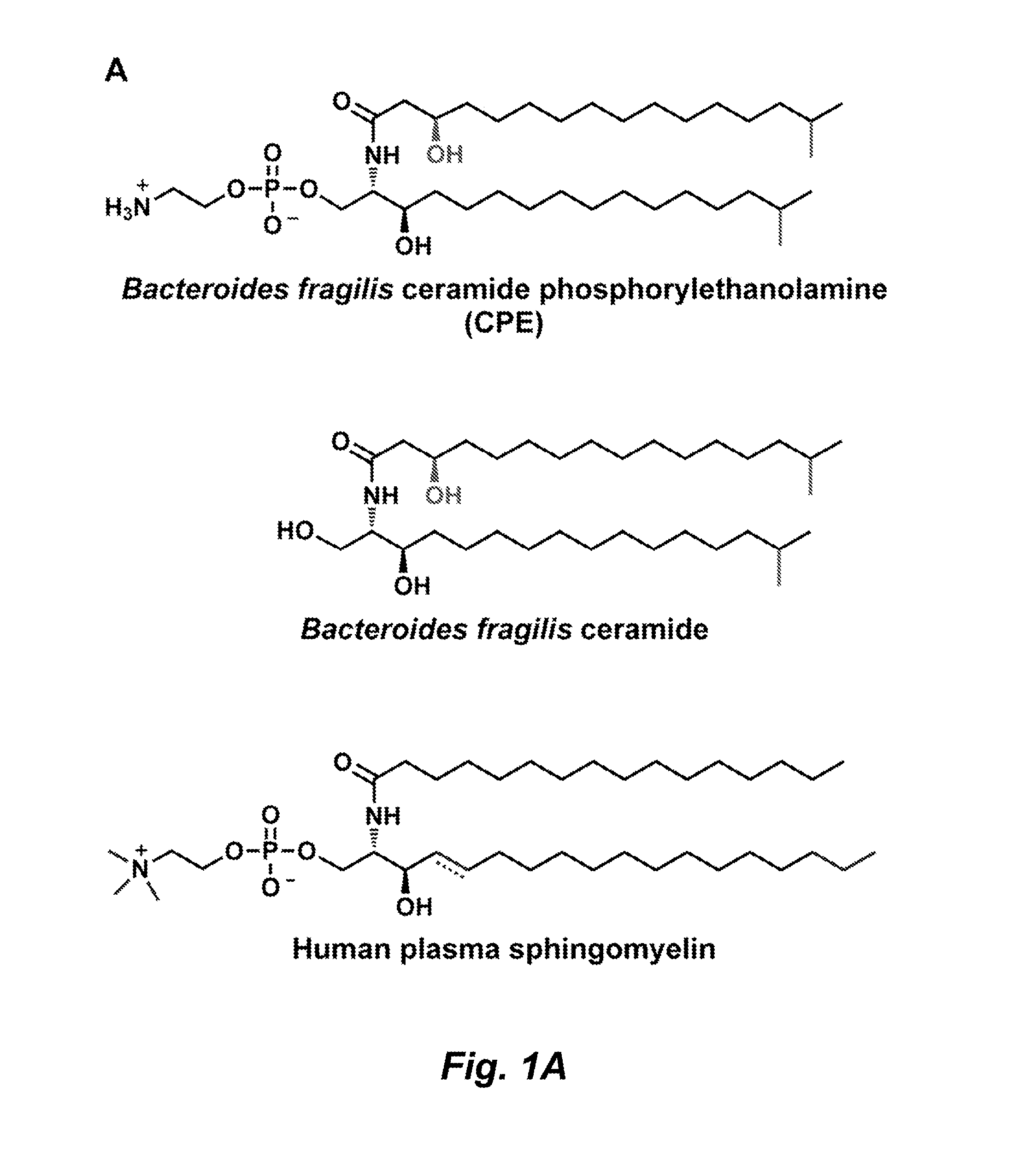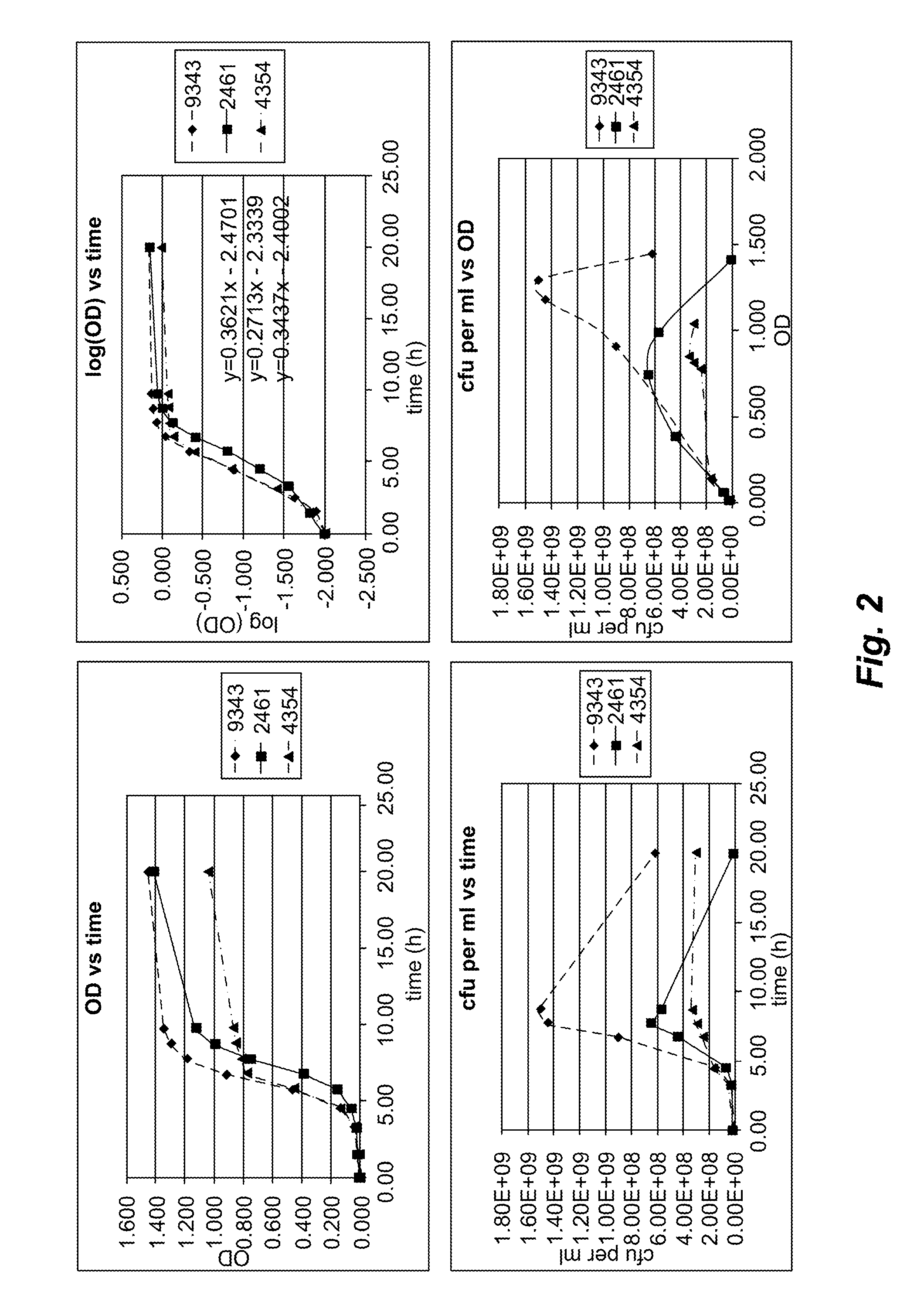Glycosphingolipids for use in modulating immune responses
a technology of glycosphingolipids and immune responses, which is applied in the direction of fatty acid chemical modification, antibody medical ingredients, phosphorous compound active ingredients, etc., can solve the problems of limiting its usefulness and not achieving the success of krn 7000, and achieve the effects of modulating the immune response, enhancing the immune response, and reducing the risk of occurren
- Summary
- Abstract
- Description
- Claims
- Application Information
AI Technical Summary
Benefits of technology
Problems solved by technology
Method used
Image
Examples
example 1
Construction of a Sphingolipid-Deficient B. fragilis Mutant
[0234]A sphingolipid-deficient mutant of B. fragilis was prepared so that sphingolipids produced by a B. fragilis wild-type strain and mutant strains could be compared.
[0235]A sphingolipid-deficient mutant of B. fragilis strain NCTC 9343 (see, e.g., Cerdeño-Tárraga et al., Science 307:1463-65 (2005)) was prepared. B. fragilis NCTC 9343 is a human gut isolate, and the genome of this strain has been sequenced. However, the genes in the Bacteroides sphingolipid pathway had not been identified. Based on an hypothesis that the Bacteroides pathway would harbor homologs of the eukaryotic pathway (see, e.g., Ikushiro et al., J Bacteriol 189:5749-61 (2007)), BLAST searches of the B. fragilis genome using the Saccharomyces cerevisiae sphingolipid biosynthetic enzymes as queries yielded two hits encoded by adjacent genes: BF2461, a putative serine palmitoyltransferase, and BF2462, a putative sphinganine kinase.
[0236]A mutant was constr...
example 2
Isolation and Characterization of B. fragilis Sphingolipids
[0240]To identify and characterize sphingolipids produced by B. fragilis, a chromatographic comparison of lipid extracts from wild-type and mutant strains was performed. Briefly, B. fragilis NCTC9343 was cultured under standard conditions, and harvested cells were extracted with CHCl3:MeOH (2:1). The organic extract was subjected to alkaline hydrolysis, neutralized, and extracted with CHCl3:MeOH (2:1). The crude extract was purified by preparative TLC(CHCl3:MeOH:H2O, 65:25:4) to give α-GalCerBf (Rf=0.6). These procedures are described in greater detail below.
[0241]Materials, General Methods, and Instrumentation Used in Sphingolipid Isolation and Purification.
[0242]All solvents were purchased from Sigma-Aldrich (St. Louis, Mo.) unless otherwise noted. Low-resolution LC-MS analysis was carried out on an Agilent 6130 LC / MS using a Phenomenex Gemini-NX 5 μm C18 110 Å 100×2 mm column at 0.7 ml / min. High-resolution LC-MS data was ...
example 3
Synthesis and characterization of B. fragilis α-GalCerBf
[0255]This example describes semi-synthetic generation of α-GalCerBf and analysis of the sphingolipid. A synthesis procedure is illustrated in the following schematic.
Semi-Synthetic Generation of α-GalCerBf.
[0256]
TMS-protected galactose (see, e.g., Bhat et al., Org. Lett. 3:2081-84 (2001) and α-iodo-substituted compound S1 (see, e.g., Schombs et al., J. Org. Chem. 75:4891-4898 (2010)) were prepared as previously described. Ceramide (5.0 mg, 0.0088 mmol) was isolated from B. fragilis NCTC 9343 as described in Example 2. α-Selective glycosylation was carried out as previously described, and α-GalCerBf was obtained after purification by preparative TLC (see Example 2) in 12% yield (0.74 mg, 0.0010 mmol). Unreacted ceramide was recovered at 52% after purification (2.6 mg, 0.0046 mmol). 1H NMR analysis (600 MHz, DMSO) of semisynthetic α-GalCerBf indicated that it was identical to α-GalCerBf isolated from B. fragilis NCTC 9343.
[0257...
PUM
| Property | Measurement | Unit |
|---|---|---|
| Composition | aaaaa | aaaaa |
| Structure | aaaaa | aaaaa |
| Immunogenicity | aaaaa | aaaaa |
Abstract
Description
Claims
Application Information
 Login to View More
Login to View More - R&D
- Intellectual Property
- Life Sciences
- Materials
- Tech Scout
- Unparalleled Data Quality
- Higher Quality Content
- 60% Fewer Hallucinations
Browse by: Latest US Patents, China's latest patents, Technical Efficacy Thesaurus, Application Domain, Technology Topic, Popular Technical Reports.
© 2025 PatSnap. All rights reserved.Legal|Privacy policy|Modern Slavery Act Transparency Statement|Sitemap|About US| Contact US: help@patsnap.com



